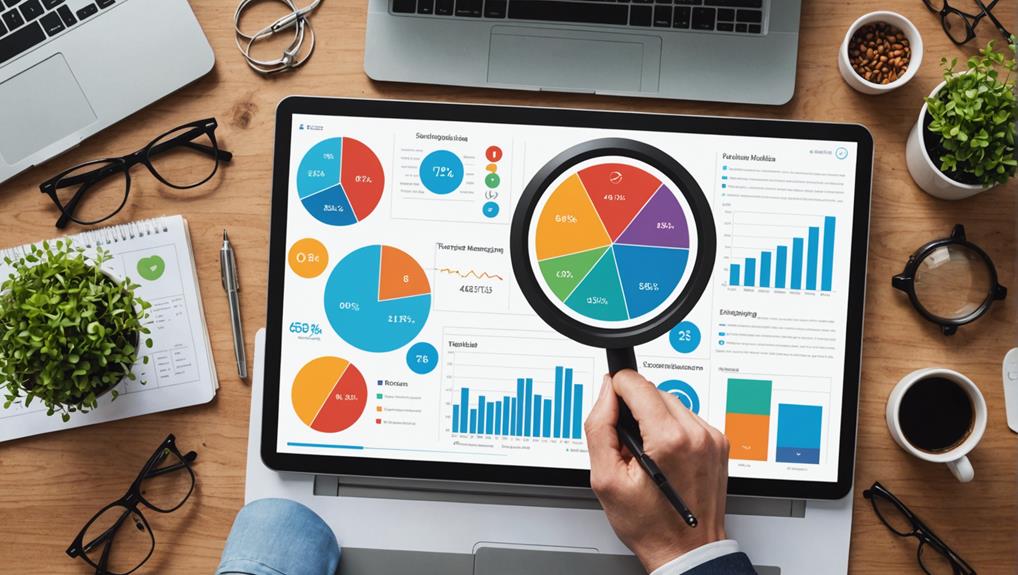To gauge influencer campaign success, focus on key metrics including reach and impressions, audience engagement, brand mentions, conversion rates, and return on investment (ROI). Reach measures unique exposure while impressions tally total views, both essential for understanding content visibility. Audience engagement, via likes and shares, indicates connection strength with the target audience. Brand mentions provide insight into the frequency and sentiment surrounding a brand. Conversion rates highlight the effectiveness of prompting desired actions, and ROI evaluates financial returns relative to campaign costs. Each metric offers strategic insights that optimize and enhance influencer partnerships to new heights of success.
Key Takeaways
- Reach measures total unique individuals exposed to content, indicating effective brand message extension.
- Engagement rate highlights audience interaction strength, calculated as (post interactions/follower count) x 100.
- Brand mentions track the frequency of brand discussions, essential for assessing campaign impact.
- Conversion rates gauge the effectiveness in prompting desired user actions like purchases.
- Return on investment (ROI) compares revenue against campaign costs, indicating financial performance.
Reach and Impressions
In the landscape of influencer marketing, understanding the metrics of reach and impressions is essential for evaluating campaign success. Reach quantifies the total number of unique individuals exposed to content, serving as a critical indicator of brand awareness. A high reach suggests that an influencer campaign effectively extends the brand’s message to a broader audience, bolstering its visibility in the marketplace.
In contrast, impressions account for every instance content appears on various platforms. This metric provides insights into content visibility and highlights the frequency with which a message is shown, offering strategic data for enhanced engagement opportunities.
Influencer partnerships thrive when brands meticulously track both reach and impressions, as these metrics collectively reveal the content’s impact. A campaign boasting 1 million impressions, for example, underscores substantial content visibility, which can lead to heightened audience interactions.
By evaluating these metrics, marketers can ascertain the efficacy of their influencer campaigns and refine future strategies. Data-driven decisions are paramount, allowing brands to optimize influencer partnerships and maximize campaign success.
Ultimately, leveraging reach and impressions as metrics to track empowers marketers to craft campaigns that resonate, ensuring sustained brand presence in a competitive digital environment.
Audience Engagement
Audience engagement stands as a vital metric for evaluating the resonance of influencer campaigns with target audiences. Metrics such as likes, shares, comments, and saves deliver qualitative insights into how influencer content connects with viewers, with 68% of marketers actively tracking these indicators.
The engagement rate, a key KPI calculated as (post interactions/follower count) x 100, effectively gauges campaign effectiveness, with higher rates typically indicating stronger audience connections. This is particularly true for smaller influencers, who often exhibit higher engagement rates, enhancing brand interaction through authentic connections with niche audiences.
User-generated content (UGC) arises as a powerful measure of audience engagement. Campaigns encouraging UGC can greatly amplify brand interaction, as evidenced by Flannels’ #PartyNeverStops campaign that generated £3.68 million in sales through active audience participation.
Tracking audience growth is also essential, as it reflects the campaign’s ability to attract and retain followers, aligning with broader marketing goals.
Furthermore, social media algorithms prioritize high-engagement posts, expanding their visibility and reach. Therefore, optimizing audience engagement is essential for improving influencer campaign outcomes.
Brand Mentions
Measuring audience engagement provides valuable insights into the effectiveness of influencer campaigns, but understanding the broader conversation surrounding a brand is equally important. Brand mentions serve as a critical metric in evaluating campaign reach and effectiveness, capturing how frequently a brand is discussed across social media platforms.
In fact, 40% of marketers actively monitor mentions and hashtags to assess their campaigns, providing a window into the community engagement and sentiment that influencers generate.
Sentiment analysis of these mentions is essential for understanding the overall perception of the brand during influencer collaborations. An increase in brand mentions post-campaign often signals successful influencer partnerships, as brands typically see spikes in discussions coinciding with influencer promotions.
Real-time monitoring through tools like Mention and Brand24 allows marketers to respond swiftly to feedback, adapting strategies as needed to enhance brand visibility and reputation.
Furthermore, analyzing brand mentions over time aids in the impact evaluation of influencer collaborations, offering insights into the long-term effects on brand visibility. By strategically monitoring mentions, marketers can pinpoint shifts in perception and engagement, ensuring that influencer campaigns are not only effective but also sustainable in maintaining positive brand visibility.
Conversion Rates
Often considered a pivotal metric in evaluating influencer campaign success, conversion rates provide a clear measure of how effectively an influencer’s content prompts users to take desired actions, such as making purchases or subscribing to services.
Within influencer marketing campaigns, the ability to track conversions accurately is essential for determining the overall effectiveness of marketing strategies. High conversion rates, typically ranging from 1-3%, reflect successful targeting and messaging, indicating that the campaign resonates well with the target audience.
Utilizing unique promo codes and trackable links allows brands to enhance campaign tracking precision. This approach not only measures success but also helps in identifying which influencers drive sales most effectively. Consequently, campaigns that emphasize driving conversions often yield a higher return on investment, evidenced by studies suggesting that these strategies can be up to 10.52 times more cost-effective than traditional paid media.
Regularly reviewing conversion metrics enables brands to refine their influencer marketing strategies. By understanding which elements of a campaign most effectively engage the target audience, marketers can optimize future efforts.
This strategic approach guarantees that influencer collaborations are not only engaging but also financially rewarding, driving sustainable growth and sales.
Return on Investment (ROI)
Building upon the insights gained from analyzing conversion rates, understanding the Return on Investment (ROI) in influencer campaigns provides a thorough view of financial performance. The ROI metric is essential for evaluating the financial effectiveness of influencer marketing by comparing the revenue generated against the campaign costs. A positive ROI signifies that the influencer marketing efforts have successfully exceeded expenses, thereby justifying the investment to stakeholders.
Remarkably, industry insights reveal that influencer marketing can be up to 10.52 times more cost-effective than traditional paid media, underscoring its potential for yielding profitable returns.
Utilizing tools like Google Analytics and specialized influencer marketing platforms enables businesses to track sales and revenue directly attributable to influencer campaigns. These tools are vital for accurate ROI assessments, ensuring campaigns meet defined financial goals.
Regular analysis and adjustment of ROI metrics are fundamental for maintaining alignment with campaign goals and identifying the most effective influencers and strategies. By focusing on metrics that matter, businesses can strategically enhance their influencer marketing efforts, ensuring that each campaign is a step towards achieving greater financial effectiveness and sustainable growth.
Understanding ROI is therefore indispensable for optimizing future influencer initiatives.
Frequently Asked Questions
How to Measure the Success of an Influencer Campaign?
To measure the success of an influencer campaign, evaluate audience engagement, brand awareness, content reach, and conversion rates. Analyze follower growth, sentiment analysis, influencer authenticity, post frequency, and audience demographics. Assess campaign ROI for thorough insights.
What Are KPIS for Influencer Marketing?
Key performance indicators for influencer marketing encompass influencer engagement, brand awareness, audience reach, content quality, conversion rates, social sentiment, campaign longevity, audience demographics, partnership authenticity, and return on investment, forming a thorough framework for strategic evaluation.
Which Metrics Would You Use to Gauge the Effectiveness of Your Campaign?
To gauge campaign effectiveness, analyze audience engagement, brand awareness, conversion rates, and reach. Assess content quality, follower growth, sentiment analysis, campaign cost, demographic insights, and influencer authenticity to guarantee strategic alignment and optimize overall impact.
What Is the Most Vital Metric to Measure Influencer Performance and Why?
The most crucial metric to measure influencer performance is engagement rate. It reflects audience authenticity and content relevance, indicating brand alignment and reach potential. Complementing conversion tracking, sentiment analysis, audience demographics, and follower growth enhances campaign longevity assessment.
Conclusion
In summary, the evaluation of influencer campaigns necessitates a strategic approach centered on quantitative metrics. Reach and impressions provide insights into the campaign’s visibility, while audience engagement indicates the level of interaction and interest generated. Brand mentions offer a qualitative measure of brand awareness, contributing to overall visibility. Conversion rates directly assess the effectiveness of the campaign in driving desired actions. Finally, analyzing the return on investment (ROI) guarantees that the campaign achieves financial objectives, thereby determining its overall success.




